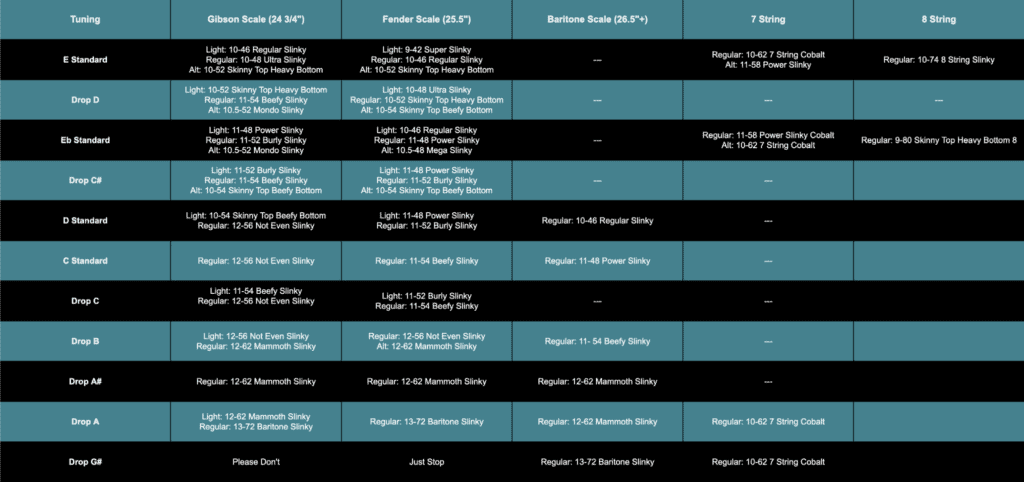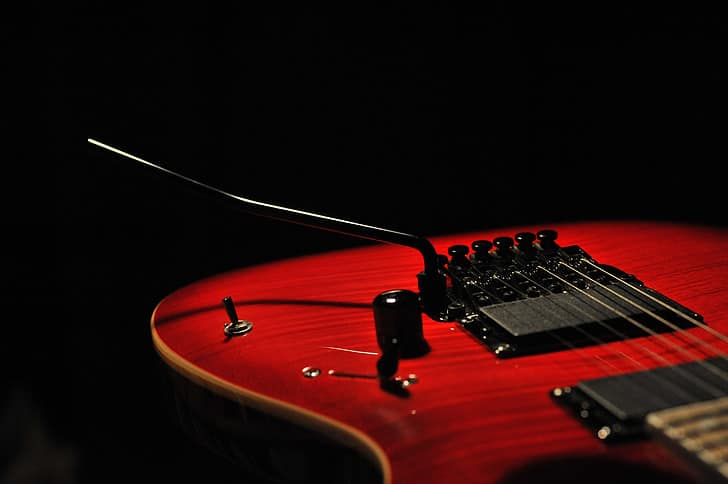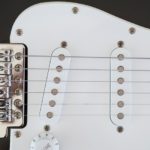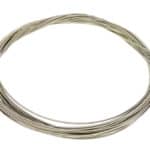What self-respecting drop-tuned devotee has not asked themselves this question?
7 vs 6! Which is better?
In the debate of ‘drop-tuned 6-string vs 7-string’, there is no distinct answer. The 7 will offer more range and dynamics (highest highs and lowest lows) whilst keeping the string gauge in a manageable realm. The 6-string, however, allows you to keep the familiar shapes and intervals, not to mention you probably already have one… or two… or five.
Time to put on some scuba gear, because we are about to dive into the depths of this topic.
What’s heavier? A 7-string guitar or a drop-tuned 6-string?
The question of what is ‘heavier’ is an infinitely deep rabbit hole that dedicated brutalists can spiral down for all eternity.
“THIS IS BRUTAL?”
“BRO! NO WAY THIS IS WAY MORE BRUTAL!”
In reality, the sonic savagery of your sound will fall to your pickups, your amp, and (most importantly) your playing style.
That being said, I tend to refer to a 7-string being ‘heavier’ due to the wonderfully wide chords that you can call upon.
These huge chords may not be the first thing you think of when you say heavy or brutal but I implore you to think of the crushingly colossal breadth of frequencies that a seven-string chord puts into a mix.
How low can you drop tune a 6-string guitar?
Theoretically, a 6-string guitar can drop so low that it finds the elusive drop Z. The limitations are set more by scale length vs string gauge than anything else.
An instrument with a longer scale length will be far more accommodating to lower tunings, not to mention that you will be able to use thinner (and more readily available) string gauges.
Though, standard 6-string guitars will range from 24.75 inches (Gibson) to 25.5 inches (Fender, Ibanez, etc.).
These scales can comfortably reach C Standard (C, F, A#, D#, G, c) or Drop B before the string gauges become the width of power lines and exert a tremendous amount of force upon your neck and your hands.
Over time this will manifest as tuning instability, most notably whilst on tour.
There is no way to avoid this catch-22, no clever little hack that grants you bestial low tuning without equipping beastly steel.
As seen below in a chart created by Fluff of ‘Riffs, Beards & Gear’ (a man who delves deep into the cavernous realms of low tunings) you can see the swiftly increasing gauge requirements for 6-strings vs the relatively easy-going needs for 7-strings.
This is due to two factors.
1. 7-string scale lengths range from 25.5 inches up to 27 inches, with most around 26.5.
2. There is only one string (the 7th) diving into the extended ranges. Ergo, you can have a regular combination of gauges and tension from strings 6 to 1 and one Jurassic Park style power cable.
For example, my string gauge for 7-string is .10 – .48 (from e to E) topped with a girthtastic .64 for a low A.
This will allow you to easily explore the neck for all it’s worth (leads, bends, and using your pinkie finger without giving yourself a compound fracture).
String Gauges Vs Tunings

Once you are aiming at tuning a 6-string so low and thus with such heavy strings, you really should take it to a local luthier to modify and set up.
Modifications for a 6-string
When getting a 6-string set up for B Standard or lower you will need to do the following:
- File out the nut and bridge saddles to accommodate such large strings.
- Adjust the truss rod to compensate for the change in tension.
- Set up your intonation.
For a more nuanced guide on dropping to demonic depths on your six-string slingers, check out our article on this specific subject.
What’s easier to play?
Whilst you can very easily adjust to any well-made 7-string neck; 6-string guitars have the honor of walking away with this award.
They are less work to reach from the top of the fretboard to the bottom and they are also the style of guitar that most guitarists begin their musical journey on.
The average string slinger will be much more at home in the familiar embrace of 6 strings rather than 7, particularly if you have smaller hands.
But as it is with all things in nature, there is a compromise. The 6 String will have the smaller, more ergonomic neck… but you will have to commit to the much larger, far less malleable strings.
An unseen advantage of the 7-string is that you can employ much more vertical motion as opposed to horizontal motion.
For example, if you want to go for a monster run in F#, from the 2nd fret on the 6th string to the 14th fret on the 1st string, you could start from the 7th fret on the 7th string and climb directly up using mostly vertical shifts from string to string.
What’s more practical?
Guitarists, despite all appearances, are constantly looking for convenience.
What gets the best job done and what gets it done the easiest?
Since 6-strings are the law of the land they will always be easier to maintain. More string options and more part options.
But an alternative way to look at this issue, particularly when touring, is that a single 7-string can take the place of two 6-strings (Standard tuning and Baritone style tuning).
Can you play the same songs on a 7-string guitar that you can on a drop-tuned 6-string?
The short answer would be yes… kind of.
If you tune your 6-string to B Standard, all the big nasty riffs that reside within the four lower strings (B, E, A, D) will be identical.
However, the next strings choose to be troublemakers… rabble-rousers that could not live in unity!
7-string tuning (B, E, A, D, G, b, e) and B Standard (B, E, A, D, F#, b) differ in their intervals between 2nd and 3rd strings. Whilst it can take a little extra brainpower, and some slight finger gymnastics, this semitone alteration can be compensated for.
Alternatively, you can slightly tweak the tuning of the 6-string to B, E, A, D, G, b. Thus mirroring the 7-string tuning, simply minus the high E. Most riffs, verses, chorus, and bridges from 7-string artists (Korn, Dream Theatre, Deftones, Behemoth, etc.) will become available to you.
You may run into issues with solos but take this as a chance to work around the lead part within your new tuning and see what you can create.
Since this is a subject we adore delving into here at Gear Aficionado, it’s worth heading over to read further on this subject.
The case for getting a 7-string guitar.
In every department the 7-string grants you more flexibility and more room to shift from traditional to modern.
Also, you can still make the savage choice to drop tune a 7-string all the way to drop F. Oh, the seismic cruelty you could inflict with such a tuning.
Are you a player that loves brutal riffs but also needs to access traditional tunings?
Do you demand a guitar that hits the highest highs and lowest lows?
Want to play Death Metal and a cover gig on one guitar?! (Seems a bit odd, but who am I to judge)
There is a common issue that occurs when this discussion is being thrown around between maniacal metalheads.
The focus of this discussion is centered on the 6th and 7th strings, instead of the 1st string.
When discussing drop tuning vs 7-string, it’s better to think of the 7-string’s range extending to the upper register.
This gives you a huge amount of extra access to dynamically voiced chords and glorious climbing leads.
When you purchase a well-made 7-string you are getting an instrument that is already geared towards every need that occurs with thicker and lower-pitched strings:
- Bridge saddles and nuts are wide enough for higher gauges.
- Pickups that are tailored to the growl and resonance of B1 (61.74 HZ)
Why might a drop-tuned 6-string be good also?
The fact is you should go with what you are more comfortable with and to most people that will be a 6-string.
You’ll be familiar with the string intervals and will be able to rely on the visual reference of the 6th string on top.
If you find yourself to be a serial chuggist and adore abusing the top string, then this option may be more accessible for you.
Alternatively, you could invest in a baritone guitar (a scale length of 27 inches or above), granting access to low rich tones with all of the tuning stability.
We here at Gear Aficionado have already dived into this subject for you. Make sure you head over and learn more about Baritone Guitars.
There are also clever options, much like the Digitech Drop pedal. A device dedicated to simply pitching your guitar down, and it does this very well.
You could be happy with your concert-tuned 6-string and only want to occasionally wade into the cruel and sadistic waters of drop tunings and this is a great tool to test out those desires.
There are many options in this field but you’ve taken the best first step, with good research.
Make sure to check out the other articles here at Gear Aficionado.

Hello there, my name is Ramiro and I’ve been playing guitar for almost 20 years. I’m obsessed with everything gear-related and I thought it might be worth sharing it. From guitars, pedals, amps, and synths to studio gear and production tips, I hope you find what I post here useful, and I’ll try my best to keep it entertaining also.





